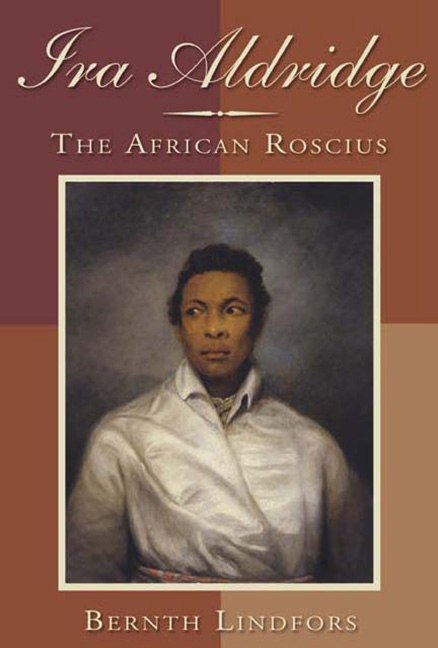Book contents
- Frontmatter
- Miscellaneous Frontmatter
- Contents
- List of Illustrations
- Acknowledgments
- Introduction
- Part One: The Life
- Part Two: The Career
- 8 Ira Aldridge's Fight for Equality
- 9 Ira Aldridge in Manchester
- 10 Acting Black: Othello, Othello Burlesques, and the Performance of Blackness
- 11 Ira Aldridge: Shakespeare and Minstrelsy
- 12 “Mislike me not for my complexion … “: Ira Aldridge in Whiteface
- 13 Ira Aldridge as Macbeth and King Lear
- 14 Creating the Black Hero: Ira Aldridge's The Black Doctor
- 15 The First American on the Zagreb Stage
- 16 A Heartwarming, Radiant Othello in the Netherlands, 1855
- 17 Ira Aldridge's Performances in Meiningen
- 18 “Othello's Occupation's Gone!” The African Roscius in Poland, 1853–67
- Notes on Contributors
- Index
- Miscellaneous Endmatter
16 - A Heartwarming, Radiant Othello in the Netherlands, 1855
from Part Two: The Career
Published online by Cambridge University Press: 26 October 2017
- Frontmatter
- Miscellaneous Frontmatter
- Contents
- List of Illustrations
- Acknowledgments
- Introduction
- Part One: The Life
- Part Two: The Career
- 8 Ira Aldridge's Fight for Equality
- 9 Ira Aldridge in Manchester
- 10 Acting Black: Othello, Othello Burlesques, and the Performance of Blackness
- 11 Ira Aldridge: Shakespeare and Minstrelsy
- 12 “Mislike me not for my complexion … “: Ira Aldridge in Whiteface
- 13 Ira Aldridge as Macbeth and King Lear
- 14 Creating the Black Hero: Ira Aldridge's The Black Doctor
- 15 The First American on the Zagreb Stage
- 16 A Heartwarming, Radiant Othello in the Netherlands, 1855
- 17 Ira Aldridge's Performances in Meiningen
- 18 “Othello's Occupation's Gone!” The African Roscius in Poland, 1853–67
- Notes on Contributors
- Index
- Miscellaneous Endmatter
Summary
With one exception, Othello has always been played in the Netherlands by white Dutch actors. Their makeup has ranged from light brown to dark black according to their conception of the role. The first black Dutch actor, Otto Sterman (1919–97) from Curaçao, was very upset with this. That there was supposed to be no black talent in the Netherlands was, for him, no excuse. Personally he had sworn to master the difficult role. At the invitation of choreographer Yvonne Georgi, Sterman played Othello in a ballet by Erika Hanka that was presented in the Landestheater in Hannover, Germany, in 1956. The emphasis clearly was on acting, because dancing was not Sterman's strong point. To give his role form, he performed as if he were part of a wheel; he was the middle point and all the dancers revolved around him. It was a successful formula. He was personally disappointed when attempts to take the ballet to the Netherlands ultimately failed.
Sterman began acting in 1935 as a West Indian servant in a dramatic interpretation of the novel Camera Obscura, by Hildebrand (pseudonym of Nicolaas Beets). In Groningen, a reviewer praised the use of living theater props: “A real dog, a real parrot, and an authentic servant from Surinam.” Thereafter he played a fakir, a Turkish masseur, and a leader of a jazz band. After twenty years of acting, playing barkeepers and taxicab drivers, Sterman had had enough of performing stereotypical roles. He wanted a chance to stand before a Dutch audience as Othello. He admired the African American actor Paul Robeson, who on the other side of the Atlantic interpreted Shakespeare to great acclaim. Did Sterman know that in the middle of the nineteenth century another accomplished black actor had preceded Robeson? Beginning in 1855, Ira Aldridge was the talk of the Netherlands. Aldridge played not only Othello but also a few white roles such as Shylock and Macbeth. His interpretation of Shakespeare was new, and his arrival on stage breathed new life into the discussion of slavery.
Around 1800, slavery was a popular theme in Western European literature, especially in drama. August von Kotzebue's De Negers (The Negroes) and De Amerikanen in Peru, of De Dood van Rolla (The Americans in Peru, or The Death of Rolla) were performed repeatedly in the Netherlands.
- Type
- Chapter
- Information
- Ira AldridgeThe African Roscius, pp. 222 - 233Publisher: Boydell & BrewerPrint publication year: 2007

